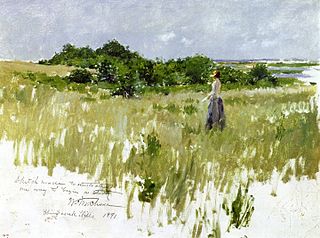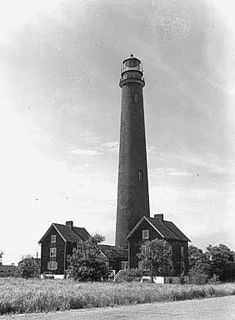This page is based on this
Wikipedia article Text is available under the
CC BY-SA 4.0 license; additional terms may apply.
Images, videos and audio are available under their respective licenses.

Hampton Bays is a hamlet and census-designated place (CDP) in Suffolk County, New York, United States. The population was 13,603 at the 2010 census.

The Hamptons, part of the East End of Long Island, comprise a group of villages and hamlets in the towns of Southampton and East Hampton, which together form the South Fork of Long Island, in Suffolk County, New York. The Hamptons form a popular seaside resort and one of the historical summer colonies of the northeastern United States.

Southampton is a village in Suffolk County, New York, United States. The village is named after the Earl of Southampton. The Village of Southampton is in the southeast part of the county in the Town of Southampton, and is colloquially known as Southampton, despite being part of the Town of Southampton. The population was 3,109 at the 2010 census.

Southampton, officially the Town of Southampton, is a town located in southeastern Suffolk County, New York, partly on the South Fork of Long Island. As of the 2010 United States Census, the town had a total population of 56,790. Southampton is included in the stretch of shoreline prominently known as The Hamptons.
Shinnecock Inlet is the easternmost of five major inlets connecting bays to the Atlantic Ocean through the narrow 100-mile-long (160 km) Outer barrier that stretches from New York City to Southampton, New York on the south shore of Long Island. It splits Westhampton Island from the peninsula extending from Southampton Village. The inlet was formed by the Great Hurricane of 1938 which killed several people when it permanently broke through the island in Hampton Bays, New York. The name comes from the Shinnecock Indian Nation.
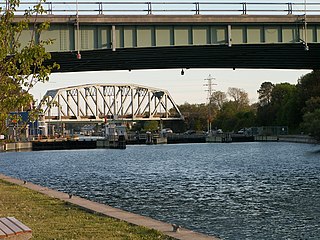
The Shinnecock Canal is a canal that cuts across the South Fork of Long Island at Hampton Bays, New York. At 4,700 feet (1,400 m) long, it connects Great Peconic Bay and the north fork of Long Island with Shinnecock Bay and the Atlantic Ocean. The canal opened to traffic in 1892.
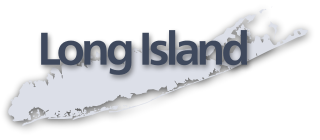
The Outer Barrier, also known as the Long Island and New York City barrier islands, refers to the string of barrier islands that divide the lagoons south of Long Island, New York from the Atlantic Ocean. These islands include Coney Island, Long Beach Barrier Island, Island Park, Jones Beach Island, Fire Island and Westhampton Island. The outer barrier extends 75 miles (121 km) along the South Shore of Long Island, from the Rockaway Peninsula in New York City to the east end of Shinnecock Bay in Suffolk County.

Moriches Inlet is an inlet connecting Moriches Bay and the Atlantic Ocean. The name Moriches comes from Meritces, a Native American who owned land on Moriches Neck.
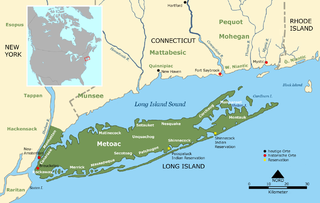
Native American peoples on Long Island are descended from two major language and cultural groups of the many Algonquian peoples who occupied Atlantic coastal areas from present-day Canada through the American South. The bands in the western part of Long Island were related to the Lenape, who had previously settled in the territory east of the Hudson River, and were related to peoples in what is now western Connecticut. Those to the east were more related culturally and linguistically to the Algonquian tribes of New England across Long Island Sound, such as the Pequot. Wood often confused Indian place names, by which the bands were known, as the names for different "tribes" living there. They were associated with geographic places.

Moriches Bay is a lagoon system on the south shore of Long Island, New York. The name Moriches comes from Meritces, a Native American who owned land on Moriches Neck.
Southampton Campus was a rail station located along the Montauk Branch of the Long Island Rail Road. Originally as a seasonal flag stop called Golf Grounds, it opened April 1907 to serve sites such as the Shinnecock Hills Golf Club and National Golf Links of America and was closed in 1939. This station will be temporarily reopened in summer 2018 to accommodate visitors to the 2018 U.S. Open Golf Championship under the name Shinnecock Hills.
Shinnecock Hills was a rail station located along the Montauk Branch of the Long Island Rail Road and first opened around 1887 on the south side of the tracks, and closed in September 1932.
Canoe Place was a station stop along the Montauk Branch of the Long Island Rail Road and first opened as a low cinder platform on the south east side of Shinnecock Canal around 1935. The station was in service for "Fisherman's Special" trains and was closed around 1953. The station was located between Hampton Bays and Suffolk Downs Stations. The hamlet where it was located is now part of Hampton Bays, New York.
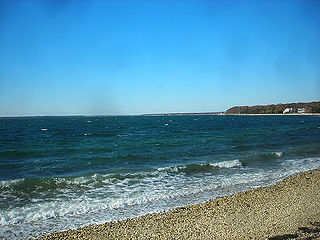
The East End of Long Island is constituted by the five townships at the eastern end of New York's Suffolk County, namely Riverhead, Southampton, Southold, Shelter Island, and East Hampton. Long Island's North Fork and South Fork are part of the East End. "The East End" is sometimes shortened as "The End", but this latter term is also applied only to Montauk, the most easterly hamlet of the contiguous land mass.



